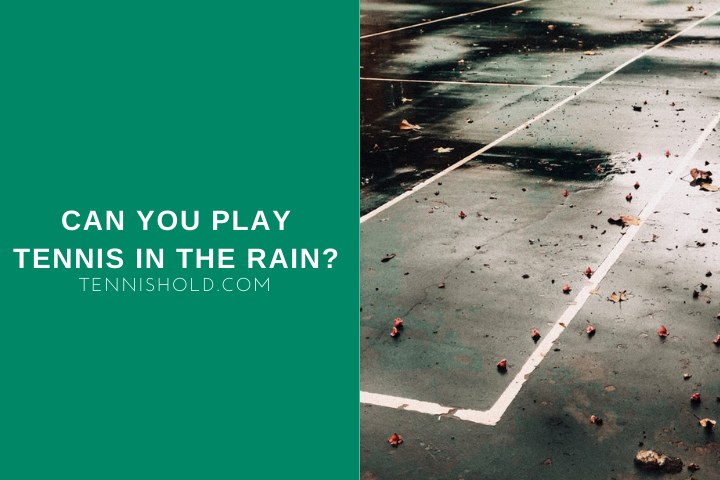Nothing beats playing tennis on a gorgeous summer day. The sun is shining, the skies are blue, and all you hear is the sound of balls being hit and people enjoying themselves.
But what about playing in the rain?
Soggy balls, soaking wet clothes, slipping and sliding all over the court. I bet at this point you’re starting to feel indoor tennis quite an attractive alternative.
You can, of course, play tennis in the rain, but it’s not recommended. When there is heavy rain, the risk of injury increases substantially. Equipment damage will also be sustained.
No piece of equipment is safe from the damage caused by rain or the playing conditions it creates. Later on, I will be talking about a helpful piece of equipment that helps speed up the court drying process. I hope you stick around.
In this article I will be covering:
- Whether you can play on a wet court
- How long it takes for a hard court to dry
- What you can do to make the court dry quicker
- How rain affects your equipment
- How playing in the rain increases the risk of injuries
Find yourself some shelter from the rain and we will get started!
Can You Play Tennis On A Wet Court?
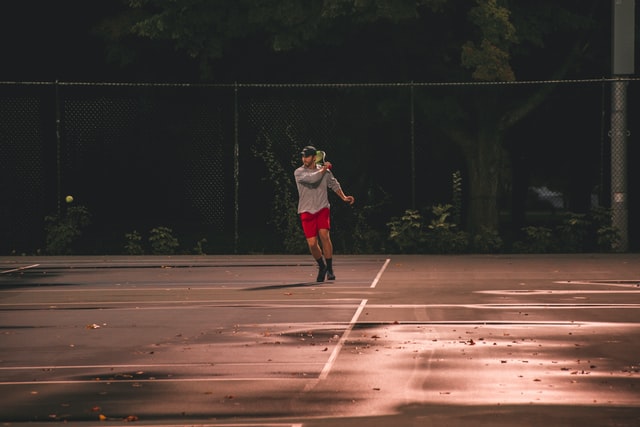
You can play tennis on a wet court but whether you should is another question. Different court surfaces react very differently to rain.
The answer when concerning grass is 100% no. The grass is a very smooth and glossy surface even without the rain being thrown into the mix.
It’s not uncommon to slip over on grass even without rain. Once the rain has splashed itself onto the court, it will start to feel more like an ice rink than a tennis court.
The risk of slipping increases dramatically on grass when it rains. This is why there is little hesitation in suspending play at Wimbledon when the rain starts to fall.
If you watch tennis on TV, you will have seen occasions when players argue with the umpire about whether the match should be suspended due to rain or not.
This debate most often occurs during professional matches held on hard courts. This is because you can play tennis on a wet hard court, but it depends on how wet it is.
What the players consider too wet may not be the same as the umpire’s assessment, and that’s when the disputes come out.
The grip on a hard court is more than grass, and from a safety aspect, you can continue playing to a certain extent. You must nonetheless pay close attention to any dips in the court; they may be more slippery.
When the rain comes down on hard courts, it is wise to gently drag your foot across the ground to assess how slippery it is before beginning a point.
Remember that when you are in the middle of a point, you will be changing direction quickly.
Do you know why Rolland Garros was the last grand slam to not feature a retractable roof on its main court? It is because clay is the surface that deals best with rain.
Clay courts require regular watering as part of their maintenance. It is thus only natural that they should be able to cope with water.
The general rule for clay courts is that as long as puddles are not forming and the lines are not slippery, it is safe to continue playing.
From watching tennis on TV, you will know that rain does not automatically lead to a suspension in play at the professional level.
At amateur level events playing through rain is more common. This is usually due to financial and time constraints, such as the organizer having the court booked for a certain amount of time.
How Long Does It Take A Hard Tennis Court To Dry?
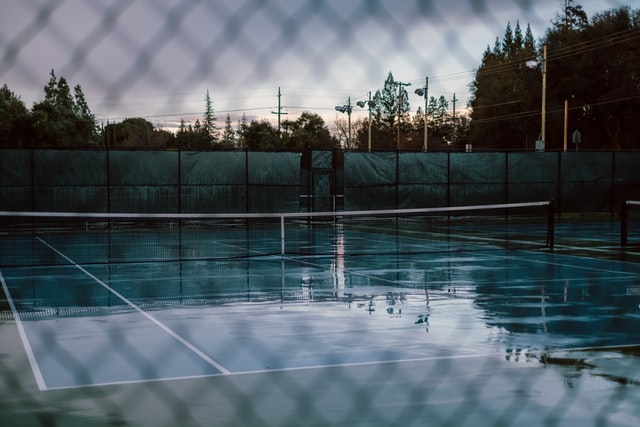
Hard courts dry much faster than grass but not as quick as clay.
The most significant contributing factor is the weather. In my experience, it generally takes anything from 30 minutes to 3 hours to dry.
In the Caribbean, it’s not uncommon to have torrential rain storms followed immediately by sunshine. In these conditions, the combination of warmth and sunlight will speed up the process.
Growing up in England, I am used to heavy downpours followed by dry and overcast weather.
These conditions don’t allow the court to dry as fast. Thus I could be waiting for as much as 3 hours after the rain has stopped before it dries.
If you have tennis courts that are damaged and have dips, puddles can build-up, increasing the time it takes to dry. Slopes will have a similar effect.
The location of the court also plays a role. If the court is in the middle of a city and surrounded by high-rise buildings blocking the sun, it will take even longer.
In this scenario, it would also mean that the court would dry faster at certain times of the day.
What Can You Do To Help The Court To Dry Quicker?
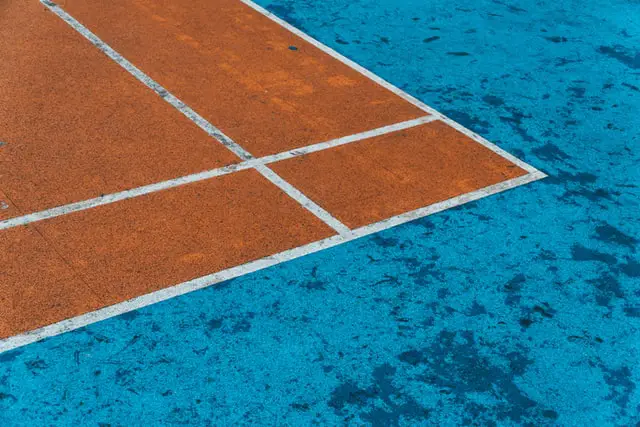
A piece of equipment regularly used to speed up the drying process on hard courts is a squeegee.
The squeegee is designed to push water off the court. As you push the squeegee, it will also spread some of the water, speeding up the drying process.
To avoid double work, the squeegee should be used after it has stopped raining. When the rain has been torrential, a squeegee can really help speed up the process. I’ve never measured it, but I reckon it’s saved me well over an hour before.
If you would like to see a squeegee in action, check out this video.
I do know of some people who try to clear the court with a standard broom. The broom method is inferior and will miss a lot of water, so I recommend investing in a squeegee.
Check out tennis court squeegee on Amazon.
The other option of course is running round the court with a hair dryer.
Will Rain Ruin Your Tennis Equipment?
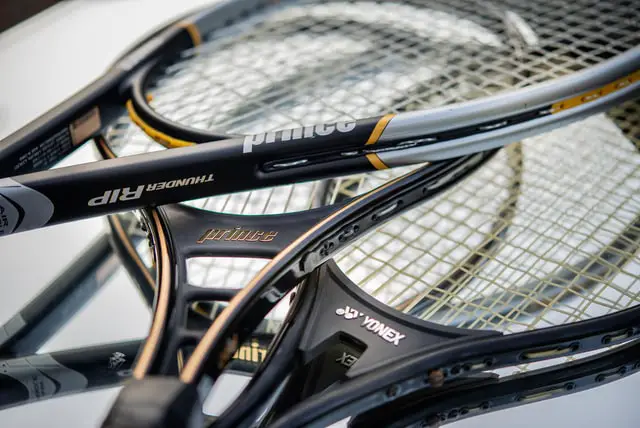
I wouldn’t go as far as to say that rain ruins your equipment, but it’s certainly not suitable for it.
The most noticeable effect of the rain is what it does to the balls. As the rain is absorbed onto the ball, it will gain weight. The weight gain is usually around 2 ounces.
The ITF (International Tennis Federation) states that tennis balls must weigh between 1.975 and 2.095 ounces. The ball is therefore doubling in weight. As the ball gains weight, it will slow down and not bounce as high.
When playing with waterlogged balls, it adds new dimensions to the game. You will start to get all sorts of strange bounces affecting the rally.
Rain will not cause long-lasting damage to the balls. It is just inconvenient as you need to wait for them to dry out. In my experience, if you put the wet balls away overnight, they are ready for play again by the morning.
The effect on the grip is more fatal. As the grip becomes absorbed with water, it will start to lose its tack. Some grips are more affected than others.
Tourna grip is regularly praised for its ability to absorb sweat. Unfortunately, its ability to absorb sweat also goes for water, and grips like this quickly become overwhelmed.
As long as your racket is not strung with a natural gut, the direct effect of rain is not severe.
The biggest concern is that the strings are now having to strike balls weighing twice as much. The stress of this will cause the strings to degrade faster.
I don’t use a natural gut myself, but I would strongly caution against using it in the rain. As it is the softest material used for tennis strings, it is particularly susceptible to rain.
Most players I know who use natural gut will carry a spare racket with different strings to use in the rain.
The greatest threat to the racket itself comes not directly from the rain but from the conditions created by the rain.
As the court becomes wet, the risk of slipping increases. When you slip, the racket will go down with you and sustain damage as it hits the ground.
Can Playing Tennis In Rain Cause Injuries?

Equipment can be replaced. You cannot.
Playing tennis in heavy rain is a high-risk activity that increases the risk of injury.
Tennis is a sport that requires a great deal of agility. Think how many times you change direction at a point. If you are changing direction on a soaking wet court, it will be a challenge keeping balance.
The greatest risk of injury comes from slipping and falling over.
In most cases, the lines are the first part of the court to get slippery. It’s therefore advisable to check this section of the court to assess how the rain is affecting the surface.
The list of injuries that can be sustained from impact due to slipping on a wet court is endless. Broken bones, soft tissue damage, sprained ankles, just to name a few.
As mentioned earlier, when tennis balls get wet, they weigh twice as much. This weight will put extra strain on your wrist and shoulder as you contact the ball.
Final Words
You may get some interesting points playing in torrential rain, but the risks really do outweigh the benefits.
The worst conditions I ever played in were at a tennis club in Thorpe bay, Essex in England.
The club was right by the beach, with torrential rain and heavy wind. In fact, the wind was so extreme that a point was won by the ball bouncing once and then coming back over the net.
What are the worst conditions you have ever played in? I’m excited to hear.

